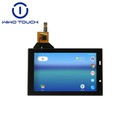In 1965, E.A Johnson of England’s Royal Radar Establishment, invented the first touchscreen that was used in the U.K for air traffic control up until around 1995. The first resistive touch screen was invented by G. Samuel Hurst in 1975, and produced in 1982. Back in 1970, Hurst and nine friends discovered that a touchscreen on a computer monitor made for an excellent method of interaction. Pressure on the cover sheet allowed voltage to flow between the X wires and the Y wires, which could be measured to indicate coordinates. This discovery helped found what we today refer to as resistive touch technology (because it responds purely to pressure rather than electrical conductivity, working with both a stylus and a finger).

Much later in 2005, three friends from France created a multi-touch screen capable of tracking any numbers of fingers. By 2005, their company named JazzMutant released the Lemur, a music controller with a multi-touch screen interface. This new technology helped influenced the TactaPad also made in 2005. Two years later, in January 2007, the iPhone was released, which was controlled entirely by a multi-touch screen. It, and the iPad which came out in September 2010, were very successful and would eventually lead to more companies adding touchscreens to their products. They included Samsung, Sony, Motorola, and many companies who adopted the touch-friendly Android operating system.
In response to the popularity of touchscreens, Microsoft, maker of the Windows family of operating systems for personal computers, would introduce a new interface in Windows 8 in 2011, which has large tiles that are meant to be easily usable with touch technology like those on tablets.It would come out the next year, along with the Microsoft Surface tablet.




